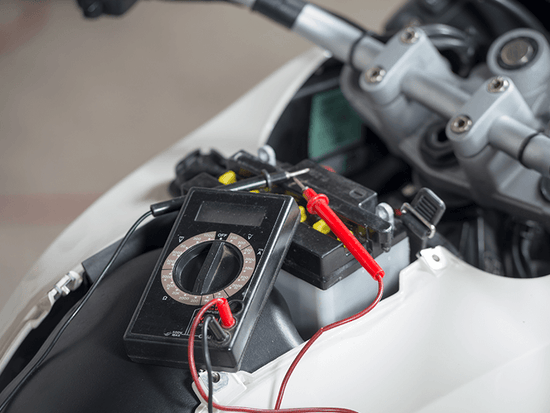Table of Content
For most motorcyclists around the world, either experienced or newbies, the horn is still the most essential equipment for maintaining road safety. It helps to indicate to other riders and drivers on the road about your presence if you are not visible to them, especially if you are approaching them from behind. A horn is also used to inform vehicles in front of you, coming to your lane without maintaining a safe distance.
For most parts of the U.S., a horn proves to be extremely helpful in avoiding collisions with deer and critters while riding a motorcycle. A horn usually lies in the same category as the turn signals as both function to indicate other vehicles on the road.
As we all know the importance of the role played by a motorcycle horn, it can be a nightmare to ride without a horn for so many riders who rely on it for safe rides. Therefore, motorcycle horns must be functional and you must keep a check on them. Continue reading this article to learn how motorcycle horns work and how to fix them in case they stop functioning.
1. How Motorcycle Horns Work
In this article, we will be discussing the working of the most widely used horns on motorcycles, called the electromagnetic horns. To understand how motorcycle horns work, we will have to go deep into the electronics and learn with the help of a diagram.
Attached below is the labeled diagram of an electromagnetic horn installed on motorcycles to help us understand in depth how it works.
Electronic Motorcycle Horn Diagram

1.1 Electronic Motorcycle Horn Components
Before we start, we need to know what makes a motorcycle horn and the electronic assembly used to produce the honk.
Housing
The outermost covering of a motorcycle horn which keeps the whole assembly intact inside it is referred to as housing.
Terminals
As you can see in the above diagram, there are two terminals through which the battery is connected and voltage is provided to the horn.
Diaphragm
A diaphragm is the most significant part of a motorcycle horn due to its being responsible for producing sound by vibrating with a very high frequency.
Tone Disc
The tone disc is placed right beside the diaphragm on the outer side and it converts the noise produced by the diaphragm into a melodious audible tone.
Contact Points
The contact points also play a key role as they open and close the circuit when the rider presses the horn button at the hand controls. As soon as the contact points meet each other, the circuit is closed, allowing the current to pass through it to produce the honking sound.
Armature
The Armature is the moving element in a motorcycle horn which moves horizontally, causing the circuit to open and close at an extremely rapid pace. This rapid horizontal movement of the armature results in a high-frequency movement of the diaphragm.
Shaft
A shaft is a rod placed at the center that holds the tone disc, diaphragm, and armature.
Field Coils
The field coils are installed right around the shaft and are responsible for generating the electromagnetic fields to cause movement of the armature.
Electromagnets
The electromagnets attached to the coil become magnets as soon as the current passes through the circuit.
1.2 How an Electronic Motorcycle Horn Works
As the rider presses the horn button, the voltage across the terminals is applied and the contact points meet each other, completing the circuit. As the current moves through the field coils and electromagnet, a magnetic field is produced which attracts the armature towards it. As the armature moves to the right towards the electromagnet, the knob on the upper side causes the contact points to detach, breaking the circuit again.
As the circuit is open, no current flows through the circuit and field coils, causing the armature to move to its original position (left). This movement of the armature towards the left removes the force applied to the right-hand contact point which comes back to its original place to meet the left-hand contact point, resulting in a closed circuit again. This to-and-fro movement of the armature continues and is so rapid to produce a high-frequency movement at the diaphragm due to being connected to the same shaft. As the diaphragm moves with an extremely high frequency, it produces a loud sound/noise which is then filtered and converted to a better and melodious sound, used as a horn.
2. Types of Motorcycle Horns

3. How to Fix Motorcycle Horn
Before you get started and open the horn installed on your motorcycle, you must first consider checking other things on the motorcycle that make the horn work normally. It is not always your motorcycle horn that requires fixing, it can be the external components not letting the current reach the horn. These external motorcycle horn problems include:
3.1 External Motorcycle Horn Issues and How to Fix Them
Faulty Horn Button
A good reason your motorcycle horn is not working is probably due to a faulty button that doesn’t seem to operate properly and activating the circuit. It can be due to dust or unwanted particles stuck between the button and the switch which makes it hard to press the horn button. Cleaning the area and removing the debris can resolve this issue. Make sure that the button presses normally.
Blown Fuse
Another reason you should be looking for, if your motorcycle horn stops working, is a blown fuse. Consider replacing the fuse if it is blown.
Defective Wiring
The most common cause of a dysfunctional or out-of-use motorcycle horn is defective wiring. If the wiring is damaged from any point throughout the connection between the press button and the horn, it will not work. You will need to replace the damaged wires to get this problem fixed.
Defective Plug
The plug that is connected to the motorcycle horn can get broken when old, resulting in the loss of connection. You may need to either fix or replace the plug for the motorcycle horn to operate.
3.2 How to Confirm If the Issue Is With Your Motorcycle Horn
Using a multimeter, you can confirm whether the issue is with the motorcycle horn or something else. Follow the below steps to find out:
- Detach the plug that is connected to your motorcycle horn while making sure that the plug terminals are accessible
- Turn on the motorcycle ignition switch
- Attach the leads to the multimeter first
- Set the multimeter’s setting to test the DC voltage
- Connect the multimeter’s probe to both the terminals of the plug
- Push the horn button on the handlebars
- Now check the voltage reading on the multimeter’s screen
- If the voltage reading on the multimeter’s screen appears to be around 12 V, it means there is nothing wrong with the motorcycle's electrical systems and you should check the horn for any issues.
Note: Even if the voltage reading at the plug’s terminals is around 12 V, your motorcycle horn may not work due to the connection problem at the plug. Clean the plug using a brush to remove any dust accumulating in the plug.
3.3 Issues with the Horn Itself
After examining the whole system, starting from the horn button on the handlebars and ending at the plug connected to the motorcycle horn, it is time to check for any issues with the horn.
Corroded Terminals
The first thing you should be examining is the horn terminals where the plug is connected. Horns are usually exposed to harsh conditions as they are open and not protected from dust, debris, and moisture. Terminals on motorcycle horns are usually affected by external conditions and therefore, get corroded. You can use a soft brush to clean the terminals of a motorcycle horn to ensure the electric connection is restored.
3.4 How to Test a Motorcycle Horn with a Multimeter
It is easy to test a motorcycle horn with a multimeter, involving only a few easy steps. These include:
- Remove the horn from your motorcycle
- Take out the multimeter
- Attach the leads with the multimeter
- Set the multimeter’s knob to check the resistance between the two terminals of the motorcycle horn
- Attach both probes of the multimeter to the terminals of the horn. You can attach the probes on any terminal of the horn as the polarity is not an issue when dealing with a motorcycle horn.
- If the multimeter shows no reading, it means the coil inside the horn has burned and you will need to buy a new horn for your motorcycle.
- If the multimeter’s screen displays a resistance of around 1.7 ohms, it means the coil is still good and there is continuity. Good news! You can fix this motorcycle horn.
3.5 How to Fix a Bike Horn
After you have found out the root cause, you can fix your motorcycle horn with ease. Consider the following steps for fixing your bike horn:
There must be a screw at the back side of the motorcycle horn. This screw is not to open the horn. By tightening and loosening this screw, you can change the distance between the contact points and can also make the horn sounds refined. Your motorcycle horn is probably not working because the screw is either too loose or has allowed dust and moisture to enter the horn. When the dust or moisture enters a horn, it causes the components to stop working.
Motorcycle horns either come with screws in the back or a tightly fixed lid to open them to access the internal components.
After uncovering your motorcycle horn by unscrewing it, clean every component using a brush carefully without damaging it. Make sure that the carbon and dust are completely removed to avoid any discontinuity in the circuit.
It is difficult to fix the motorcycle horn that doesn’t come with screws to open them. To fix them, you can open the only screw at their back for contact points adjustment. After opening this screw, you can either put some petrol or a cleaning solution inside the horn through the screw hole.
Do not put too much petrol or cleaning solution inside the horn. Shake well until the dust, rust, and any sort of blockage are completely removed from the components inside the horn, and then drain the solution from the same screw hole. You can see the dirt dissolved in the solution coming out from the horn. Make sure there is no liquid inside and the solution is completely evaporated. Give the horn at least 30 minutes to become completely dry before we make the connections.
As soon as the motorcycle horn becomes dry, put the screw again and tighten it up until it touches the contact point.
Using sandpaper, sand the motorcycle horn terminals until they become shiny again to make sure the current passes through them easily.
Before you install the horn on the motorcycle again, make sure you test it first by applying 12 V across its terminals.
If you found no issues with the coil in the initial phase after testing the motorcycle horn with the multimeter, there are high chance that it will start to work now after fixing.
You can change the quality of sound produced by a motorcycle horn by adjusting the screw at the back.
After it starts working, install the horn back on your motorcycle.
4. Bike Horn Not Working After Rain
Horns on motorcycles usually start showing problems after rain and then eventually become dead. It is because of the moisture that finds its way inside the horn and results in corrosion. The components inside a motorcycle horn need to be completely free of dust and rust to stay functional.
5. The Bottom Line
Motorcycle horns are underrated motorcycle parts but they have a huge role to play when it comes to safely riding a bike. It can be a nightmare for many riders if you find out during the ride that your horn is not working. Therefore, you must always keep a check before you go for a ride that your turn indicators and horns are working, otherwise, you may fail sometimes to register your presence on the road which can put your safety at risk. Keeping a horn functional is sometimes difficult, particularly if it is excessively exposed to dust and moisture. Knowing how motorcycle horns work and how to fix them is a great way to start learning about motorcycles. Next time your motorcycle horn doesn’t work, this article can help you fix it with ease.
6. Get Your Bike Ready for Touring
Motorcycle horns may not add to the beauty of your motorcycle but improve your road safety. Viking Bags , a leading motorcycle luggage bags , and aftermarket parts manufacturer makes superior quality parts that not only add to the beauty but improve the performance capabilities of your bike. You can choose from saddlebags , tank bags , backpacks , tour packs , tool bags , sissy bar bags , and dozens of other options to carry luggage on long motorcycle trips.
The company also specializes in making aftermarket parts that fit perfectly on your motorbike and adjust it according to your style and taste. These include handlebars , seats , sissy bars , crash bars , fairings , and backrests.







Leave a comment
All comments are moderated before being published.
This site is protected by reCAPTCHA and the Google Privacy Policy and Terms of Service apply.